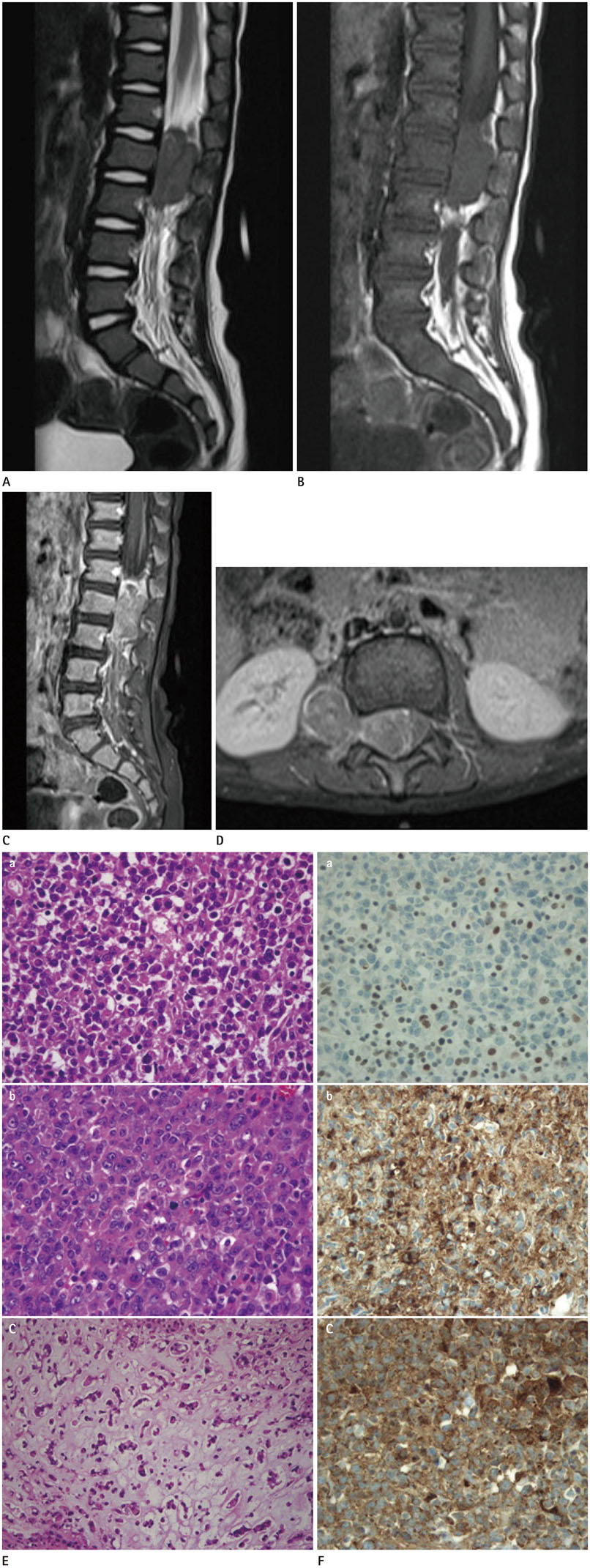J Korean Soc Radiol.
2018 Jun;78(6):417-421. 10.3348/jksr.2018.78.6.417.
Atypical Teratoid/Rhabdoid Tumor of Lumbar Spine in an Infant: A Case Report
- Affiliations
-
- 1Department of Radiology, Inje University, Ilsan Paik Hospital, Goyang, Korea. kyh@paik.ac.kr
- 2Department of Pathology, Inje University, Ilsan Paik Hospital, Goyang, Korea.
- 3Department of Neurological Surgery, Inje University, Ilsan Paik Hospital, Goyang, Korea.
- KMID: 2412361
- DOI: http://doi.org/10.3348/jksr.2018.78.6.417
Abstract
- Atypical teratoid/rhabdoid tumor (AT/RT) of spine usually reported to develop in the brain, while it rarely manifest in the spine. It consists of rhabdoid cells and is highly malignant. AT/RT appears at various sites throughout the body, such as in the central nervous system, liver, kidneys, abdomen, and soft tissues. Among them, spinal AT/RT is rare, and AT/RT of lumbar spine is extremely rare; only a few cases have been reported. We present the case of an AT/RT of lumbar spine in a 16-month-old boy.
MeSH Terms
Figure
Reference
-
1. Yang CS, Jan YJ, Wang J, Shen CC, Chen CC, Chen M. Spinal atypical teratoid/rhabdoid tumor in a 7-year-old boy. Neuropathology. 2007; 27:139–144.
Article2. Agrawal A, Bhake A, Cincu R. Giant lumbar paraspinal atypical teratoid/rhabdoid tumor in a child. J Cancer Res Ther. 2009; 5:318–320.
Article3. Dhir A, Tekautz T, Recinos V, Murphy E, Prayson RA, Ruggieri P, et al. Lumbar spinal atypical teratoid rhabdoid tumor. J Clin Neurosci. 2015; 22:1988–1989.
Article4. Chao MF, Su YF, Jaw TS, Chiou SS, Lin CH. Atypical teratoid/ rhabdoid tumor of lumbar spine in a toddler child. Spinal Cord Ser Cases. 2017; 3:16026.
Article5. Beckwith JB, Palmer NF. Histopathology and prognosis of Wilms tumors: results from the first national Wilms' tumor study. Cancer. 1978; 41:1937–1948.6. Rorke LB, Packer RJ, Biegel JA. Central nervous system atypical teratoid/rhabdoid tumors of infancy and childhood: definition of an entity. J Neurosurg. 1996; 85:56–65.
Article7. Moeller KK, Coventry S, Jernigan S, Moriarty TM. Atypical teratoid/rhabdoid tumor of the spine. AJNR Am J Neuroradiol. 2007; 28:593–595.8. Biegel JA, Tan L, Zhang F, Wainwright L, Russo P, Rorke LB. Alterations of the hSNF5/INI1 gene in central nervous system atypical teratoid/rhabdoid tumors and renal and extrarenal rhabdoid tumors. Clin Cancer Res. 2002; 8:3461–3467.9. Packer RJ, Biegel JA, Blaney S, Finlay J, Geyer JR, Heideman R, et al. Atypical teratoid/rhabdoid tumor of the central nervous system: report on workshop. J Pediatr Hematol Oncol. 2002; 24:337–342.
Article10. Tekautz TM, Fuller CE, Blaney S, Fouladi M, Broniscer A, Merchant TE, et al. Atypical teratoid/rhabdoid tumors (ATRT): improved survival in children 3 years of age and older with radiation therapy and high-dose alkylator-based chemotherapy. J Clin Oncol. 2005; 23:1491–1499.
Article
- Full Text Links
- Actions
-
Cited
- CITED
-
- Close
- Share
- Similar articles
-
- Imaging Findings of Atypical Teratoid/Rhabdoid Tumor of Infancy & Childhood in CNS: Report of Two Cases
- A Case of Central Nervous System Atypical Teratoid/Rhabdoid Tumor of The 4th Ventricle : A Highly Malignant Tumor in Infancy and Childhood Frequently Mistaken for Medulloblastoma
- Atypical Teratoid Rhabdoid Tumors in Adult Patient with Multiple Lesions
- A Case of Atypical Teratoid/Rhabdoid Tumor Arising from the Supratentorial Area
- Classical malignant rhabdoid tumor of central nervous system in 9-year-old Korean


